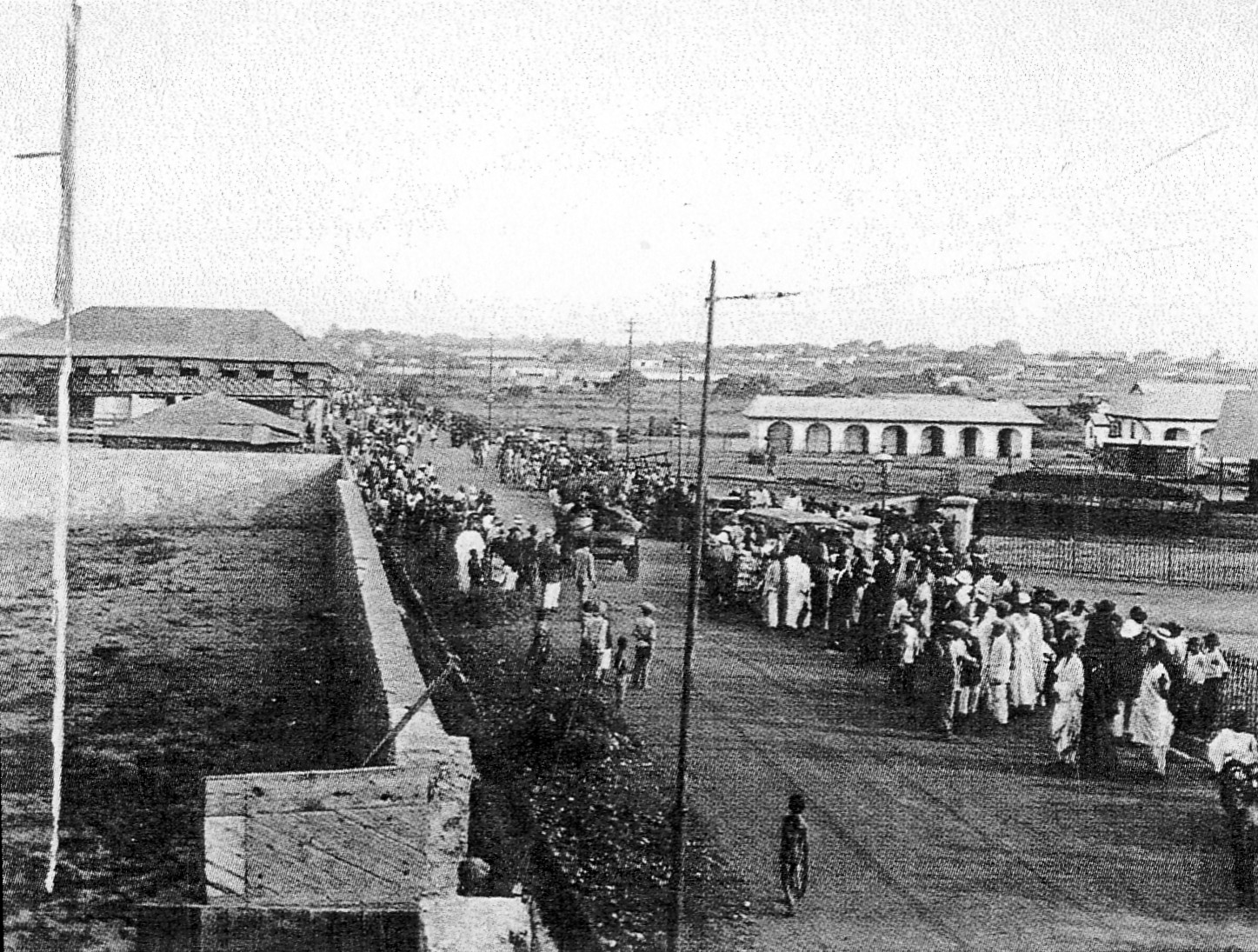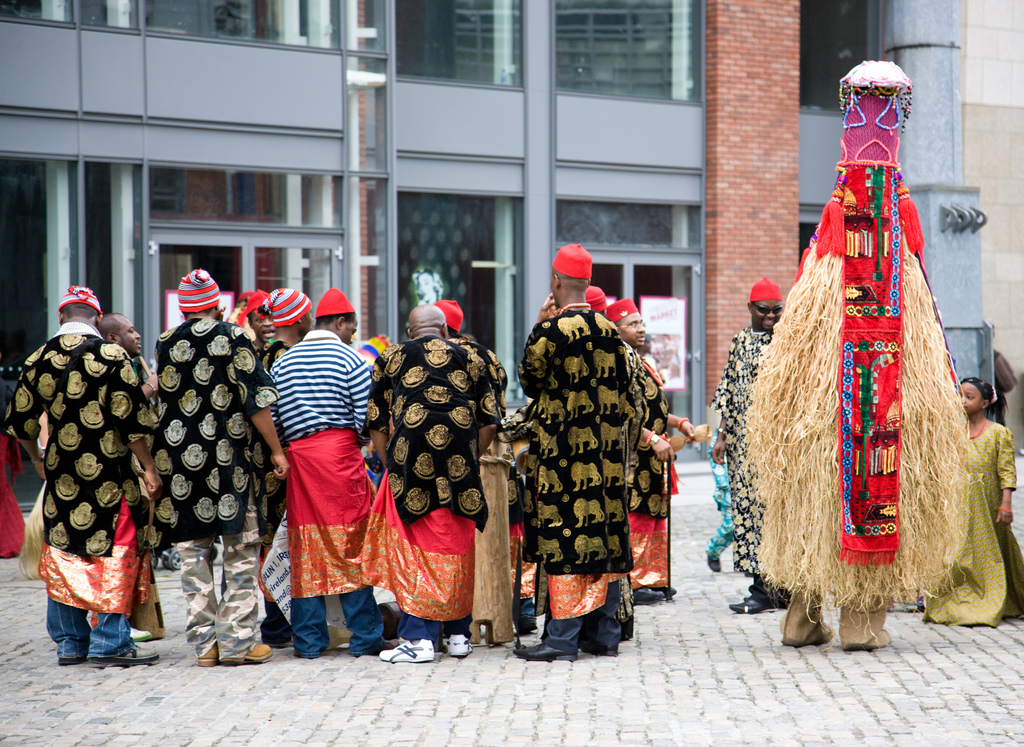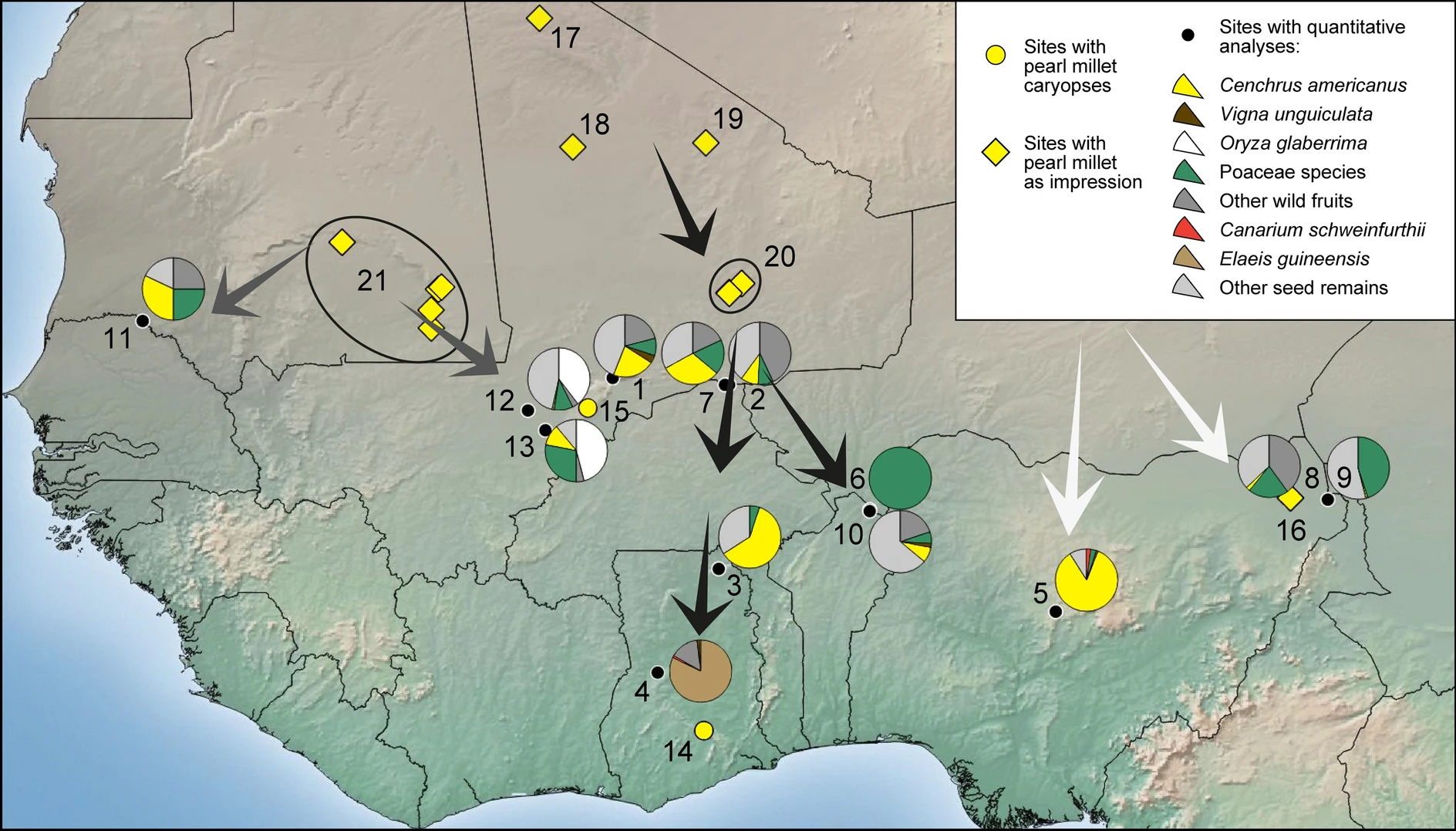|
Junkanoo
Junkanoo (also Jonkonnu) is a festival that originated during the period of African chattel slavery in British American colonies. It is practiced most notably in The Bahamas, Jamaica and Belize, and historically in North Carolina and Miami, where there are significant settlements of West Indian people during the post-emancipation era. In the present day, there are considerable variations in performance and spelling, but there are the shared elements of masquerade (or masking), drumming, dance, and parading. In many territories, Junkanoo is observed around the week of Christmas. These Christmas-time parades are predominantly showcased in Jamaica. In The Bahamas, it was initially called Junkanoo and is said to date back to the 1700s where it is celebrated year round. In Belize, where the music is also mainstreamed, competition results are hotly contested. There are also Junkanoo parades in Miami in June and Key West in October, where local black populations have their roots in ... [...More Info...] [...Related Items...] OR: [Wikipedia] [Google] [Baidu] |
John Canoe
John Canoe, also known as January Conny, (died circa 1725) was the European name given to an Akan warrior from Axim, Ghana. He was a chief of the Ahanta people in the early 18th century, who established a stronghold in the defunct Fort Fredericksburg and fought multiple wars with European traders for twenty years. The stronghold finally fell in 1725, though Canoe's fate is unknown. He is commemorated in the Junkanoo festival held in the Caribbean each December. History Origin of John Canoe January Conny (also named ''John Kenu'', ''Johann Kuny'', ''John Conrad'', ''Johann Cuny'', ''Jean Cunny'', ''January Konny'' or ''John Conni'' by German, Dutch, British or French-language designation) was a powerful Gold Coast merchant. Conny had a private army and was an ally of Brandenburg-Prussia at the time of the Brandenburger Gold Coast colony (1683–1720) in Axim on the coast of present-day Ghana in West Africa. Between 25 December 1708 to 1724 he took over control of the abandoned ... [...More Info...] [...Related Items...] OR: [Wikipedia] [Google] [Baidu] |
The Bahamas
The Bahamas, officially the Commonwealth of The Bahamas, is an Archipelagic state, archipelagic and island country within the Lucayan Archipelago of the Atlantic Ocean. It contains 97 per cent of the archipelago's land area and 88 per cent of its population. It comprises more than 3,000 islands, cays and islets in the Atlantic Ocean, and is located north of Cuba and north-west of the island of Hispaniola (split between the Dominican Republic and Haiti) and the Turks and Caicos Islands, southeast of the U.S. state of Florida and east of the Florida Keys. The Capital city, capital and largest city is Nassau, The Bahamas, Nassau on the island of New Providence. The Royal Bahamas Defence Force describes the Bahamas' territory as encompassing of ocean space. The Bahama islands were inhabited by the Arawak and Lucayan people, Lucayans, a branch of the Arawakan-Taino language, speaking Taíno, for many centuries. Christopher Columbus was the first European to see the islands, making ... [...More Info...] [...Related Items...] OR: [Wikipedia] [Google] [Baidu] |
Kingston, Jamaica
Kingston is the Capital (political), capital and largest city of Jamaica, located on the southeastern coast of the island. It faces a natural harbour protected by the Palisadoes, a long spit (landform), sand spit which connects the town of Port Royal and Norman Manley International Airport to the rest of the island. Kingston is the largest English-speaking city south of the United States in the Western Hemisphere. The local government bodies of the parishes of Kingston Parish, Kingston and Saint Andrew Parish, Jamaica, Saint Andrew were amalgamated by the Kingston and St. Andrew Corporation Act of 1923, to form the Kingston and St. Andrew Corporation (KSAC). Greater Kingston, or the "Corporate Area" refers to those areas under the KSAC; however, it does not solely refer to Kingston Parish, which only consists of the old downtown and Port Royal. Kingston Parish had a population of 89,057, and St. Andrew Parish had a population of 573,369 in 2011 Kingston is only bordered by Sain ... [...More Info...] [...Related Items...] OR: [Wikipedia] [Google] [Baidu] |
Los Angeles Times
The ''Los Angeles Times'' is an American Newspaper#Daily, daily newspaper that began publishing in Los Angeles, California, in 1881. Based in the Greater Los Angeles city of El Segundo, California, El Segundo since 2018, it is the List of newspapers in the United States, sixth-largest newspaper in the U.S. and the largest in the Western United States with a print circulation of 118,760. It has 500,000 online subscribers, the fifth-largest among U.S. newspapers. Owned by Patrick Soon-Shiong and published by California Times, the paper has won over 40 Pulitzer Prizes since its founding. In the 19th century, the paper developed a reputation for civic boosterism and opposition to Trade union, labor unions, the latter of which led to the Los Angeles Times bombing, bombing of its headquarters in 1910. The paper's profile grew substantially in the 1960s under publisher Otis Chandler, who adopted a more national focus. As with other regional newspapers in California and the United Sta ... [...More Info...] [...Related Items...] OR: [Wikipedia] [Google] [Baidu] |
Homowo
Homowo is a festival celebrated by the Ga people of Ghana in the Greater Accra Region. The festival starts at the end of April into May with the planting of crops (mainly millet) before the rainy season starts. The Ga people celebrate Homowo in the remembrance of famine that once happened in their history in precolonial Ghana. The Ga Homowo or Harvest Custom is an annual tradition among the Accra people, with its origin tied to the Native Calendar and the Damte Dsanwe people of the Asere Quarter. Asere is a sub-division of the Ga Division in the Accra District of the Gold Coast Colony. The word Homowo (''Homo'' - hunger, ''wo'' - hoot) can mean "to hoot (or jeer) at hunger" in the Ga language.The Library of Congress's article on Homowo. Retrieved 08 September 07 It is said that as the Ga people traveled to Ghana, they faced famine and other misfortunes along the way and upon settlement. The people attributed their mishaps and misfortunes to the displeasure of a god or deity. ... [...More Info...] [...Related Items...] OR: [Wikipedia] [Google] [Baidu] |
Yoruba People
The Yoruba people ( ; , , ) are a West African ethnic group who inhabit parts of Nigeria, Benin, and Togo, which are collectively referred to as Yorubaland. The Yoruba constitute more than 50 million people in Africa, are over a million outside the continent, and bear further representation among the African diaspora. The vast majority of Yoruba are within Nigeria, where they make up 20.7% of the country's population according to Ethnologue estimations, making them one of the largest List of ethnic groups of Africa, ethnic groups in Africa. Most Yoruba people speak the Yoruba language, which is the Niger–Congo languages, Niger-Congo language with the largest number of native or L1 speakers. Geography In Africa, the Yoruba culture, Yoruba are contiguous with the Yoruboid languages, Yoruboid Itsekiri to the south-east in the northwest Niger Delta, Bariba people, Bariba to the northwest in Benin and Nigeria, the Nupe people, Nupe to the north, and the Ebira to the northeast in ... [...More Info...] [...Related Items...] OR: [Wikipedia] [Google] [Baidu] |
Egungun
Egungun, Yoruba language: Egúngún, also known as Ará Ọ̀run (The collective dead) in the broadest sense is any Yoruba masquerade or masked, costumed figure. More specifically, it is a Yoruba masquerade for ancestor reverence, or the ancestors themselves as a collective force. ''Eégún'' is the reduced form (abbreviation through syllable elision) of the word ''egúngún'' and has the same meaning. There is a misconception that Eegun/Egun (Yoruba language: Eégún) is the singular form, or that it represents the ancestors while Egúngún is the masquerade or the plural form. This misconception is common in the Americas by Orisa devotees that do not speak Yorùbá language as a vernacular. Egungun is a visible manifestation of the spirits of departed ancestors who periodically revisit the human community for remembrance, celebration, and blessings. Classification of Egungun types The classification of Egun or Egungun types, might appear to be a fairly straightforward ta ... [...More Info...] [...Related Items...] OR: [Wikipedia] [Google] [Baidu] |
Igbo People
The Igbo people ( , ; also spelled Ibo" and historically also ''Iboe'', ''Ebo'', ''Eboe'', / / ''Eboans'', ''Heebo''; natively ) are an ethnic group found in Nigeria, Cameroon, Gabon, and Equatorial Guinea. Their primary origin is found in modern-day Abia State, Abia, Anambra State, Anambra, Ebonyi State, Ebonyi, Enugu State, Enugu, and Imo States, while others can be found in the Niger Delta and along the Cross River. The Igbo people are one of the largest List of ethnic groups of Africa, ethnic groups in Africa. The Igbo language is part of the Niger–Congo languages, Niger-Congo language family. Its regional dialects are mutually intelligible amidst the larger "Igboid languages, Igboid" cluster. The Igbo homeland straddles the lower Niger River, east and south of the Edoid languages, Edoid and Idomoid languages, Idomoid groups, and west of the Lower Cross River languages, Ibibioid (Cross River) cluster. Before the period of Colonial Nigeria, British colonial rul ... [...More Info...] [...Related Items...] OR: [Wikipedia] [Google] [Baidu] |
New Yam Festival Of The Igbo
The New Yam Festival of the Igbo people (known as Orureshi in Idoma, or Iwa ji, Iri ji, Ike ji, or Otute depending on dialect) is an annual cultural festival by the Igbo people that is held at the end of the rainy season in early August.Yam Festival Retrieved 11 May 2009. Daniels, Ugo. ''African Loft''. 6 November 2007 Iwa ji Ofu (New Yam Festival) In Igboland! Retrieved 11 May 2009. The Iri ji festival (literally "''new-yam eating''")Omenuwa, Onyema. ''TheWeek''. 22 Nov 2007. Republished by [...More Info...] [...Related Items...] OR: [Wikipedia] [Google] [Baidu] |
Akan People
The Akan () people are a kwa languages, Kwa group living primarily in present-day Ghana and in parts of Ivory Coast and Togo in West Africa. The Akan speak languages within the Central Tano languages, Central Tano branch of the Potou–Tano languages, Potou–Tano subfamily of the Niger–Congo languages, Niger–Congo family.''Languages of the Akan Area: Papers in Western Kwa Linguistics and on the Linguistic Geography of the Area of Ancient''. Isaac K. Chinebuah, H. Max J. Trutenau, Linguistic Circle of Accra, Basler Afrika Bibliographien, 1976, pp. 168. Subgroups of the Akan people include: the Adansi, Agona, Akuapem people, Akuapem, Akwamu, Akyem, Anyi people, Anyi, Ashanti people, Asante, Baoulé people, Baoulé, Bono people, Bono, Chakosi people, Chakosi, Fante people, Fante, Kwahu, Sefwi people, Sefwi, Wassa, Ahanta people, Ahanta, Denkyira and Nzema people, Nzema, among others. The Akan subgroups all have cultural attributes in common; most notably the tracing of royal m ... [...More Info...] [...Related Items...] OR: [Wikipedia] [Google] [Baidu] |
Cowbell
A cowbell (or cow bell) is a bell (instrument), bell worn around the neck of free-roaming livestock so herders can keep track of an animal via the sound of the bell when the animal is grazing out of view in hilly landscapes or vast plains. Although they are typically referred to as "cow bells" due to their extensive use with cattle, the bells are used on a wide variety of animals. Characteristics and uses The bell and clapper are commonly crafted from iron, bronze, brass, copper, or wood. The collar (animal), collar used to hold the bell is traditionally made with leather and wood fibers. The craftsmanship of cow bells varies by geographic location and culture. Most cow bells are made of thin, flat pieces of plated sheet metal. Plating causes the sheet metal to have a surface which can be decorated or left plain. The ornaments on the cow bell and the collar are usually decorative although some cultures believe that certain ornaments Amulet, provide or enhance magical prote ... [...More Info...] [...Related Items...] OR: [Wikipedia] [Google] [Baidu] |
The Washington Post
''The Washington Post'', locally known as ''The'' ''Post'' and, informally, ''WaPo'' or ''WP'', is an American daily newspaper published in Washington, D.C., the national capital. It is the most widely circulated newspaper in the Washington metropolitan area and has a national audience. As of 2023, the ''Post'' had 130,000 print subscribers and 2.5 million digital subscribers, both of which were the List of newspapers in the United States, third-largest among U.S. newspapers after ''The New York Times'' and ''The Wall Street Journal''. The ''Post'' was founded in 1877. In its early years, it went through several owners and struggled both financially and editorially. In 1933, financier Eugene Meyer (financier), Eugene Meyer purchased it out of bankruptcy and revived its health and reputation; this work was continued by his successors Katharine Graham, Katharine and Phil Graham, Meyer's daughter and son-in-law, respectively, who bought out several rival publications. The ''Post ... [...More Info...] [...Related Items...] OR: [Wikipedia] [Google] [Baidu] |








